Repeated Impact Damage Behavior and Damage Tolerance of Bio-Inspired Helical-Structured Glass Fiber Resin Matrix Composites
Abstract
1. Introduction
2. Material and Experimental Procedure
2.1. Composite Material and Manufacturing
2.2. Experimental Procedure
3. Numerical Modeling
3.1. Composite Damage Model
3.1.1. In-Plane Constitutive Model
3.1.2. Cohesive Constitutive Model
3.2. Finite Element Model
4. Experimental Results and Discussion
4.1. Repeated Impact Response
4.2. Non-Destructive Testing
4.3. CAI Behavior
5. Numerical Results and Discussion
5.1. Validation of Numerical Model
5.2. Optimal Design of Laminates
6. Conclusions
Author Contributions
Funding
Institutional Review Board Statement
Data Availability Statement
Conflicts of Interest
References
- Barouni, A.K.; Dhakal, H.N. Damage Investigation and Assessment Due to Low-Velocity Impact on Flax/Glass Hybrid Composite Plates. Compos. Struct. 2019, 226, 111224. [Google Scholar] [CrossRef]
- Patel, S.; Guedes Soares, C. Reliability Assessment of Glass Epoxy Composite Plates Due to Low Velocity Impact. Compos. Struct. 2018, 200, 659–668. [Google Scholar] [CrossRef]
- Donough, M.J.; Prusty, B.G.; Van Donselaar, M.J.; Morozov, E.V.; Wang, H.; Hazell, P.J.; Philips, A.W.; John, N.A.S. In-Plane and Oblique Edge-on Impact on Thick Glass-Fibre/Epoxy Composite Laminates. Int. J. Impact Eng. 2023, 171, 104373. [Google Scholar] [CrossRef]
- Atas, C.; Sayman, O. An Overall View on Impact Response of Woven Fabric Composite Plates. Compos. Struct. 2008, 82, 336–345. [Google Scholar] [CrossRef]
- Nassir, N.A.; Gharkan, M.R. Impact Response of Composite Laminates Based on Epoxy and Glass Fibre. Mater. Today Proc. 2021, 42, 1901–1907. [Google Scholar] [CrossRef]
- Amaro, A.M.; Reis, P.N.B.; de Moura, M.F.S.F.; Neto, M.A. Influence of Multi-Impacts on GFRP Composites Laminates. Compos. Part B Eng. 2013, 52, 93–99. [Google Scholar] [CrossRef]
- Guha, S.; Singh, A.K. Transference of SH Waves in a Piezoelectric Fiber-Reinforced Composite Layered Structure Employing Perfectly Matched Layer and Infinite Element Techniques Coupled with Finite Elements. Finite Elem. Anal. Des. 2022, 209, 103814. [Google Scholar] [CrossRef]
- Liu, J.L.; Pham, V.N.H.; Mencattelli, L.; Chew, E.; Chua, P.Y.; Shen, J.; Tian, K.; Zhi, J.; Jiang, D.; Tay, T.E.; et al. Improving the Impact Performance of Natural Fiber Reinforced Laminate Through Hybridization and Layup Design. Compos. Sci. Technol. 2024, 251, 110585. [Google Scholar] [CrossRef]
- Chen, W.; Liu, J.; Cao, X.; Li, C.B.; Li, Y.; Li, X. Study on Projectile Impact Resistance of Carbon-Glass Hybrid Bioinspired Helical Composite Laminate. Mater. Today Commun. 2024, 39, 108703. [Google Scholar] [CrossRef]
- Rai, S.; Rawat, P. Three-Point Bending, Interlaminar Shear, and Impact Strength in Bioinspired Helicoidal Basalt Fiber/Epoxy Composites: A Comparative Experimental Analysis. Polym. Compos. 2024, 45, 9407–9420. [Google Scholar] [CrossRef]
- Zhao, S.; Yin, X.; Zhang, D. A study of a Bio-Inspired Impact Resistant Carbon Fiber Laminate with a Sinusoidal Helicoidal Structure in the Mandibles of Trap-Jaw Ants. Acta Biomater. 2023, 169, 179–191. [Google Scholar] [CrossRef]
- Zhang, B.; Yang, J.; Li, Y.; Zhang, J.; Niu, S.; Han, Z.; Ren, L. Bioinspired Basalt Fiber Composites with Higher Impact Resistance Through Coupling Sinusoidal and Helical Structures Inspired by Mantis Shrimp. Int. J. Mech. Sci. 2023, 244, 108073. [Google Scholar] [CrossRef]
- Yang, F.; Xie, W.; Meng, S. Global Sensitivity Analysis of Low-Velocity Impact Response of Bio-Inspired Helicoidal Laminates. Int. J. Mech. Sci. 2020, 187, 106110. [Google Scholar] [CrossRef]
- Guan, L.; Peng, W.; Wen, R.N.J.; Fan, J.; Le Ferrand, H. Izod Impact Resistance of 3D Printed Discontinuous Fibrous Composites with Bouligand Structure. NPG Asia Mater. 2023, 15, 60. [Google Scholar] [CrossRef]
- Yang, R.; Wang, H.; Wang, B.; Zhang, S.; Huang, Z.; Yin, S. Sinusoidally Architected Helicoidal Composites Inspired by the Dactyl Club of Mantis Shrimp. Int. J. Smart Nano Mater. 2023, 14, 321–336. [Google Scholar] [CrossRef]
- ASTM D7136/D7136M-15; Standard Test Method for Measuring the Damage Resistance of a Fiber-Reinforced Polymer Matrix Composite to a Drop-Weight Lmpact Event. ASTM International: West Conshohocken, PA, USA, 2015.
- ASTM D3039/D3039M-17; Standard Test Method for Tensile Properties of Polymer Matrix Composite Materials. ASTM International: West Conshohocken, PA, USA, 2017.
- ASTM D3410/D3410M-16; Standard Test Method for Compressive Properties of Polymer Matrix Composite Materials with Unsupported Gage Section by Shear Loading. ASTM International: West Conshohocken, PA, USA, 2016.
- ASTM D7078/D7078M-12; Standard Test Method for Shear Properties of Composite Materials by V-Notched Rail Shear Method. ASTM International: West Conshohocken, PA, USA, 2012.
- Lyu, Q.; Wang, B.; Guo, Z. Predicting Post-Impact Compression Strength of Composite Laminates Under Multiple Low-Velocity Impacts. Compos. Part A Appl. Sci. Manuf. 2023, 164, 107322. [Google Scholar] [CrossRef]
- ASTM D7137/D7137M-12; Standard Test Method for Compressive Residual Strength Properties of Damaged Polymer Matrix Composite Plates. ASTM International: West Conshohocken, PA, USA, 2012.
- Lapczyk, I.; Hurtado, J.A. Progressive Damage Modeling in Fiber-Reinforced Materials. Compos. Part A Appl. Sci. Manuf. 2007, 38, 2333–2341. [Google Scholar] [CrossRef]
- Puck, A.; Schürmann, H. Failure Analysis of FRP Laminates by Means of Physically Based Phenomenological Models. Compos. Sci. Technol. 1998, 58, 1633–1662. [Google Scholar] [CrossRef]
- Catalanotti, G.; Camanho, P.P.; Marques, A.T. Three-Dimensional Failure Criteria for Fiber-Reinforced Laminates. Compos. Struct. 2013, 95, 63–79. [Google Scholar] [CrossRef]
- Benzeggagh, M.L.; Kenane, M. Measurement of Mixed-Mode Delamination Fracture Toughness of Unidirectional Glass Epoxy Composites with Mixed-Mode Bending Apparatus. Compos. Sci. Technol. 1996, 56, 439–449. [Google Scholar] [CrossRef]

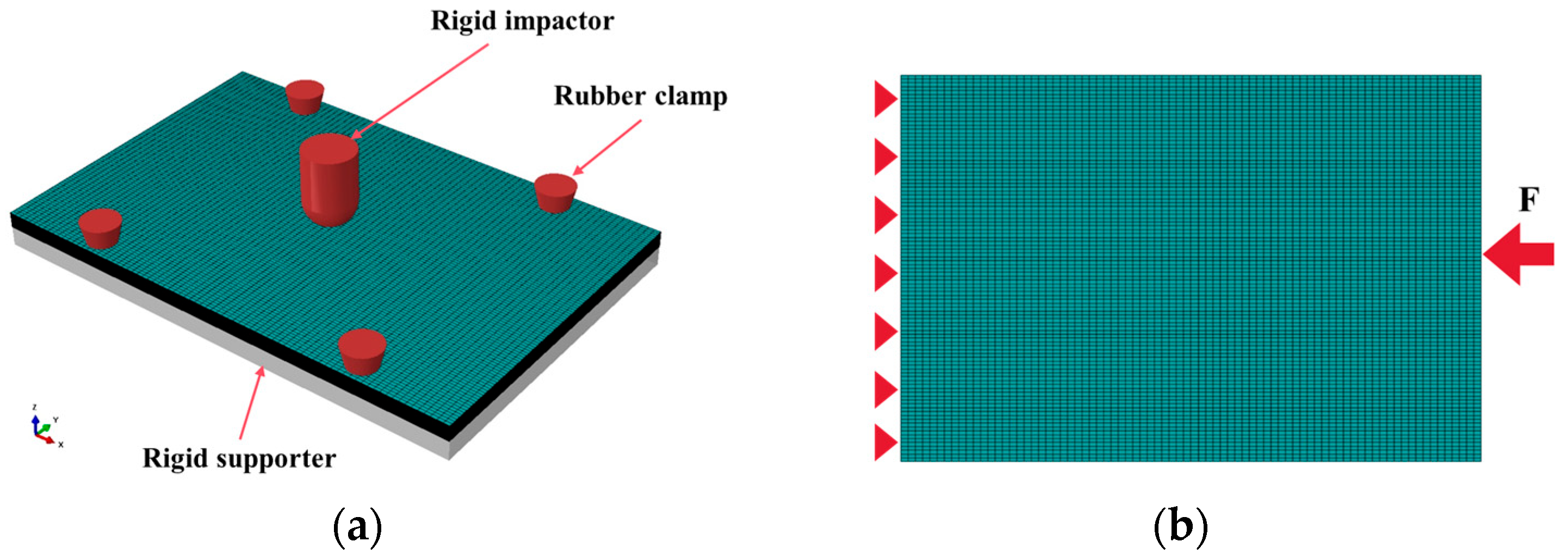
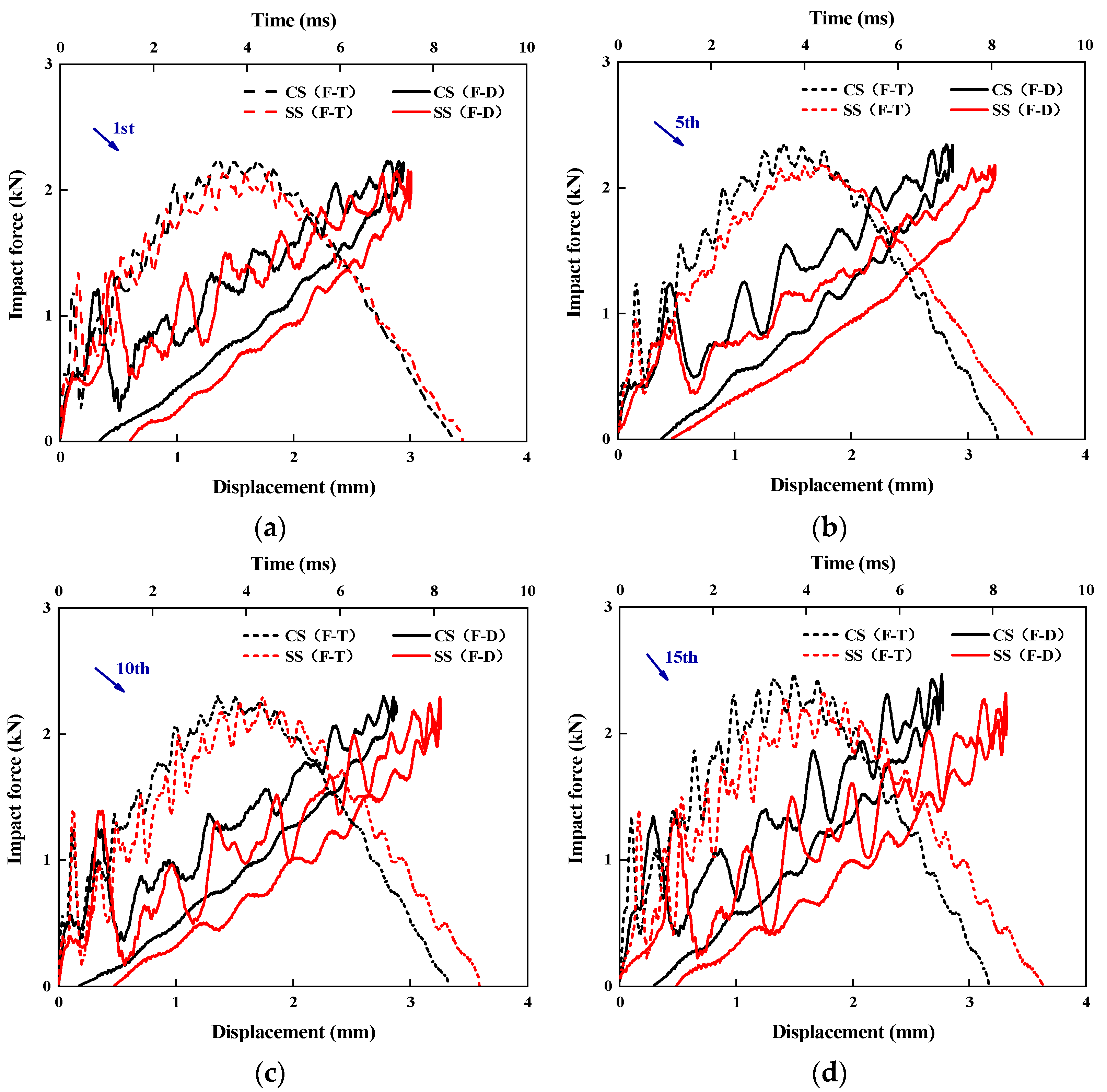
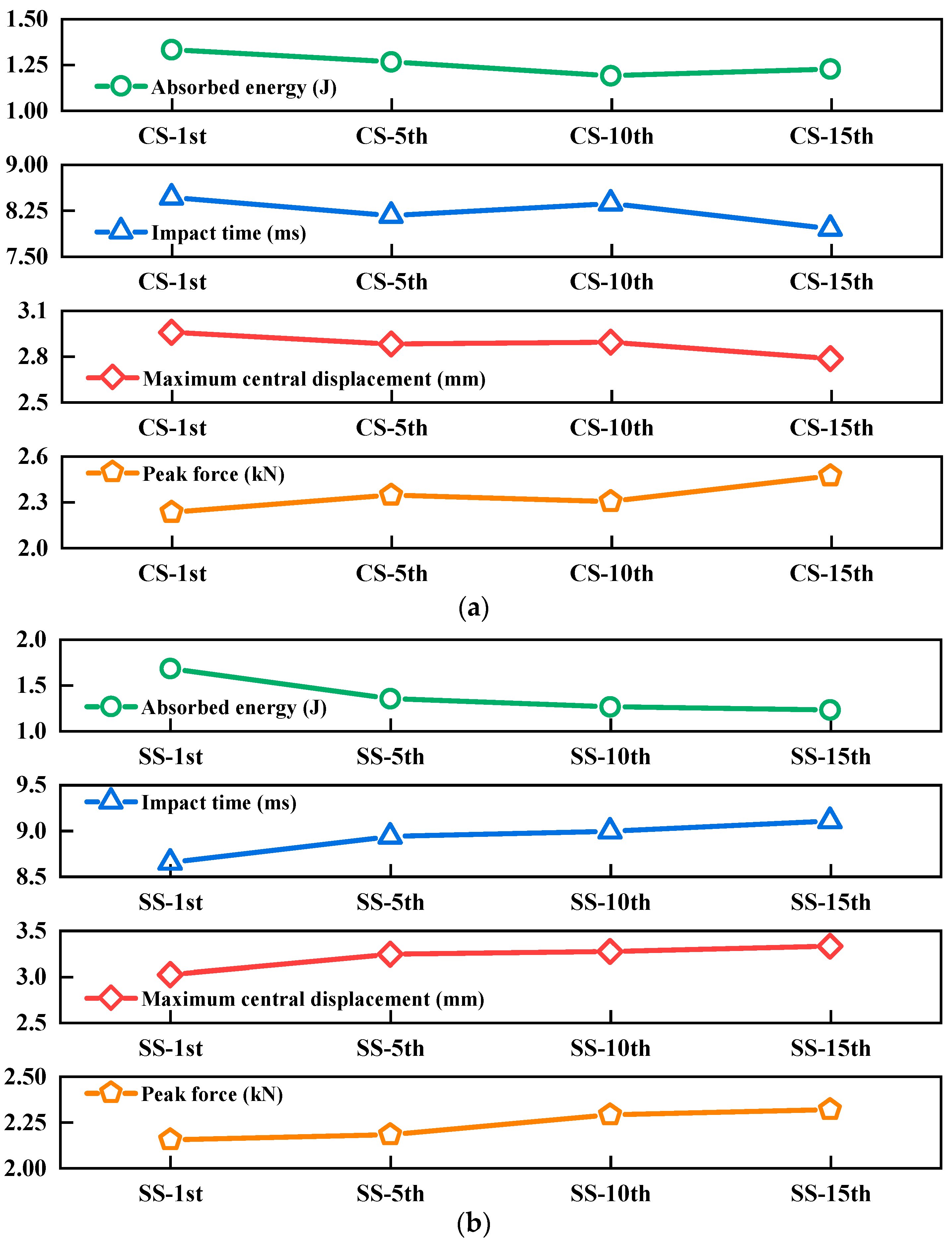
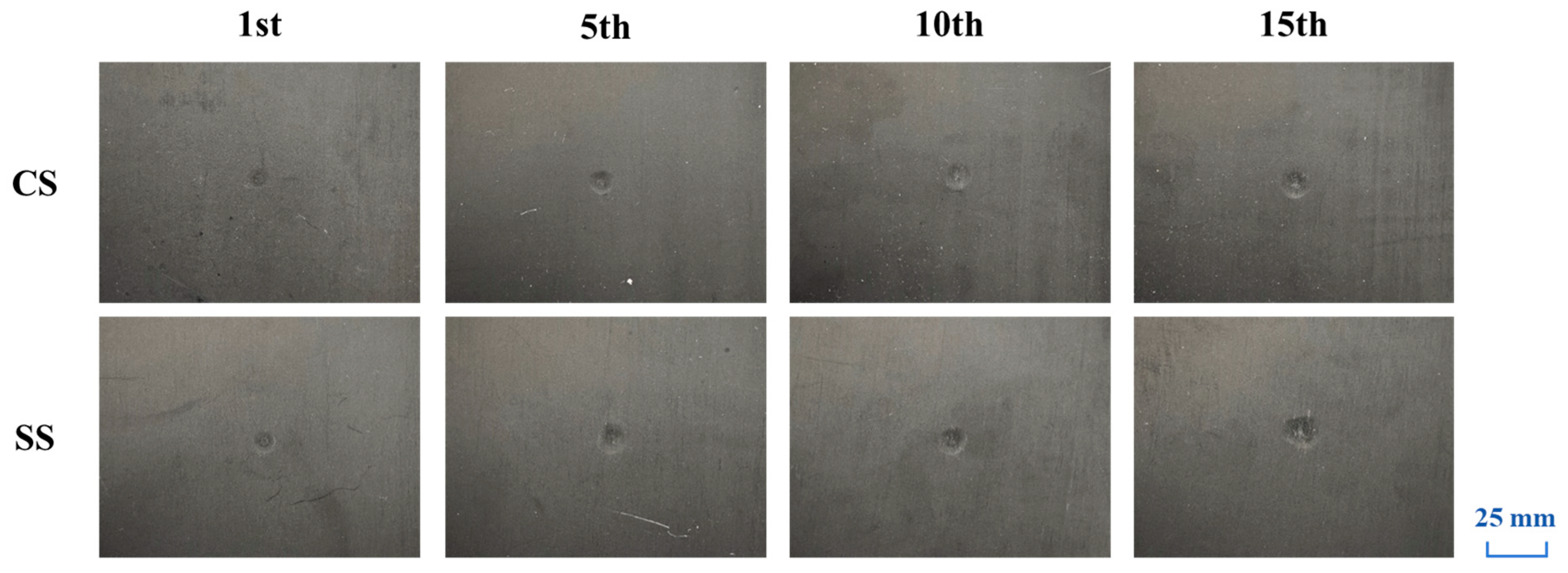
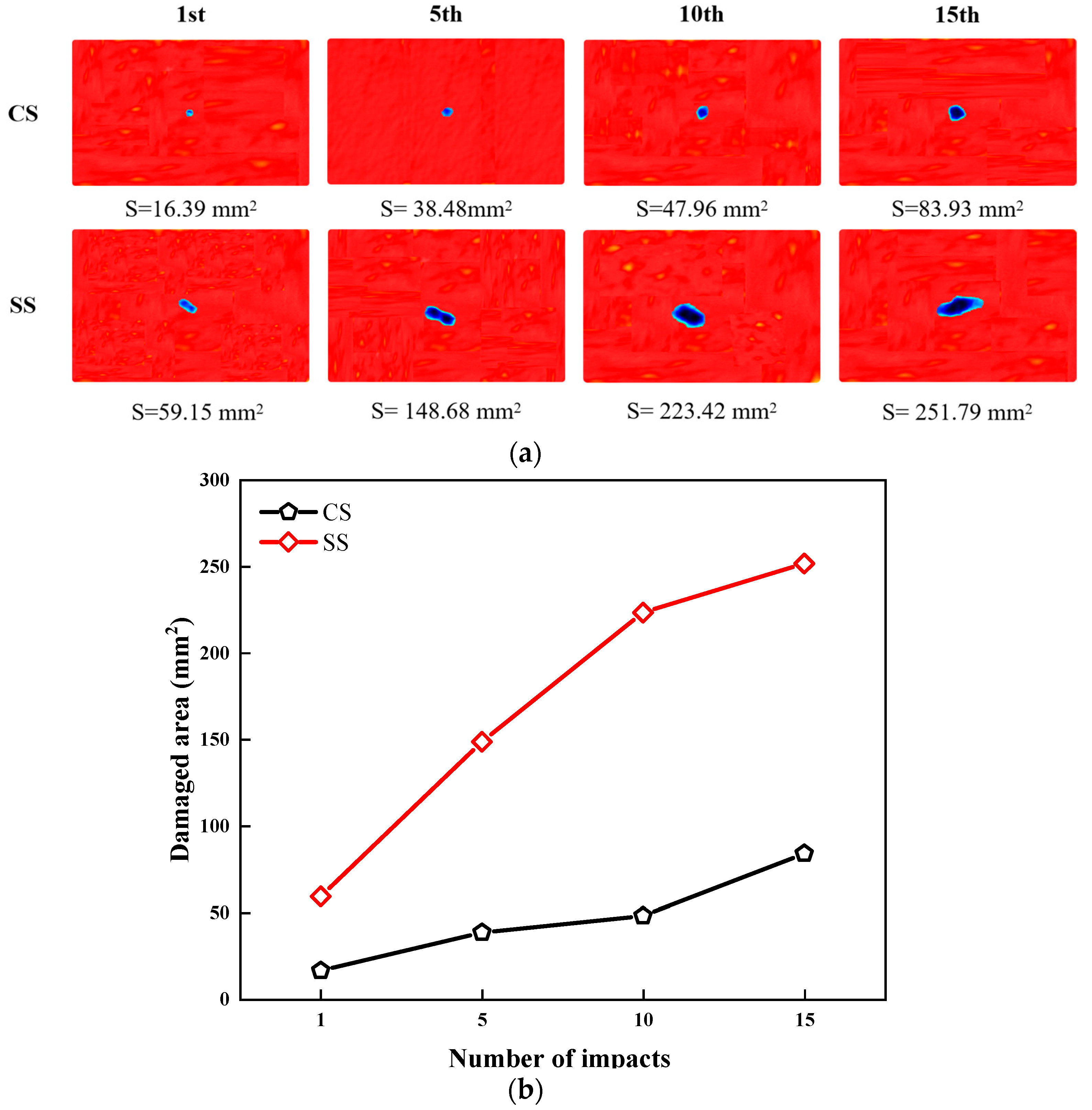


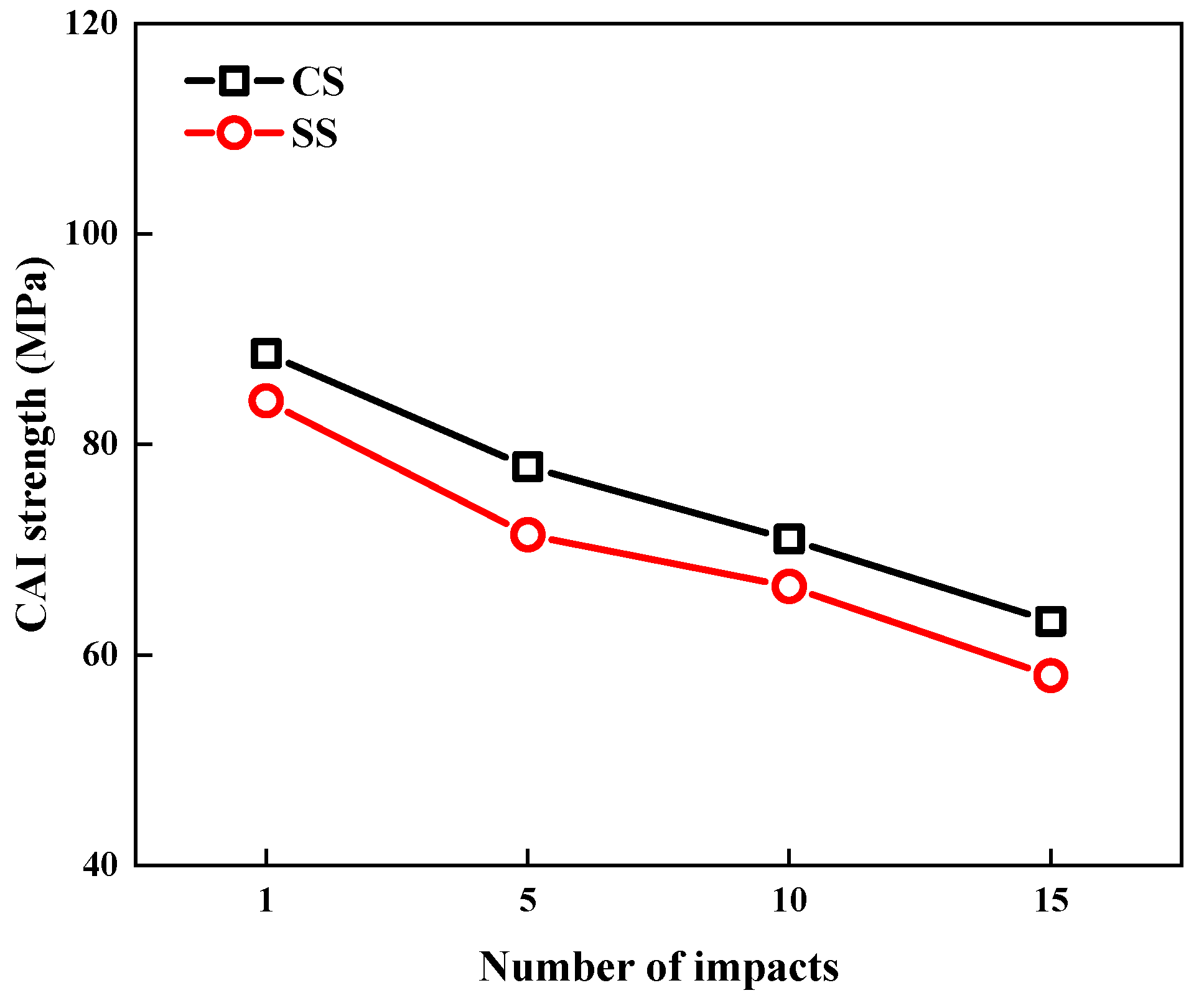



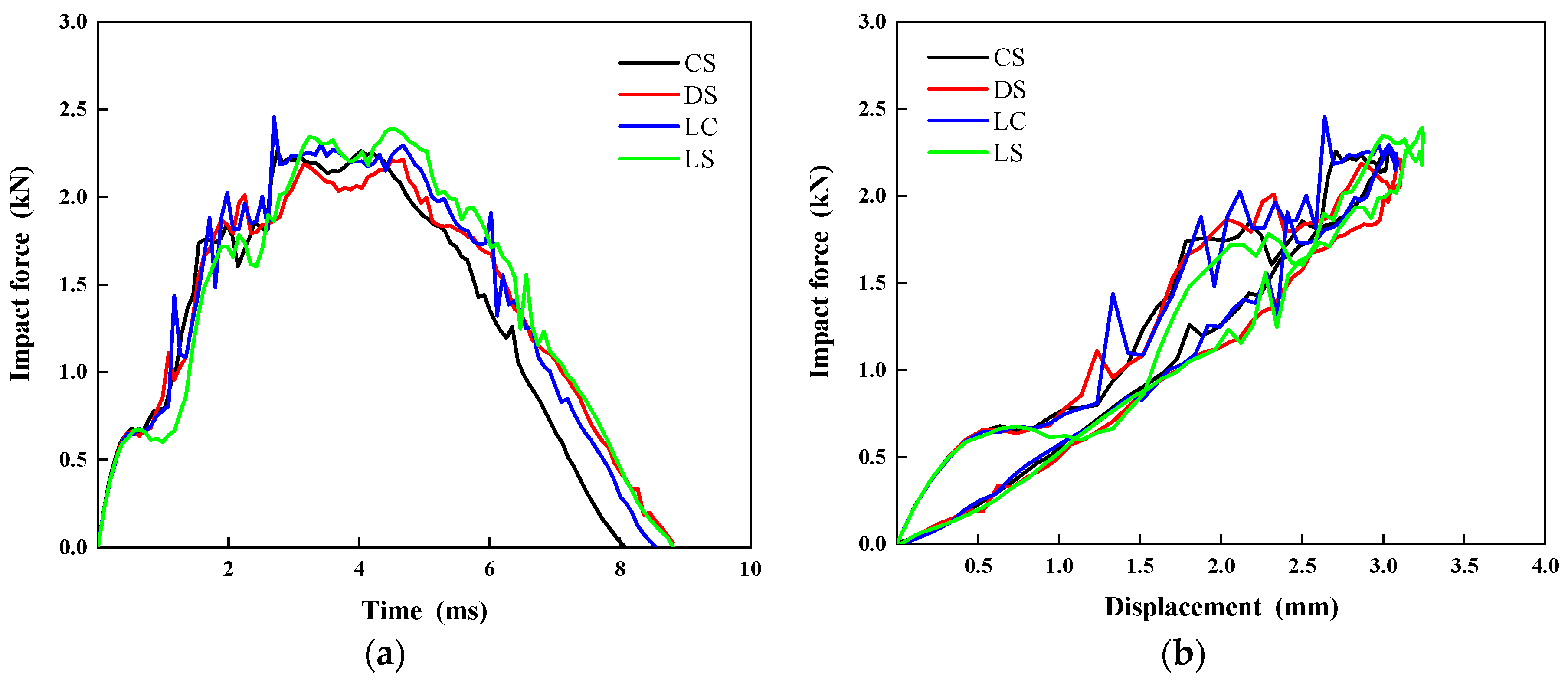

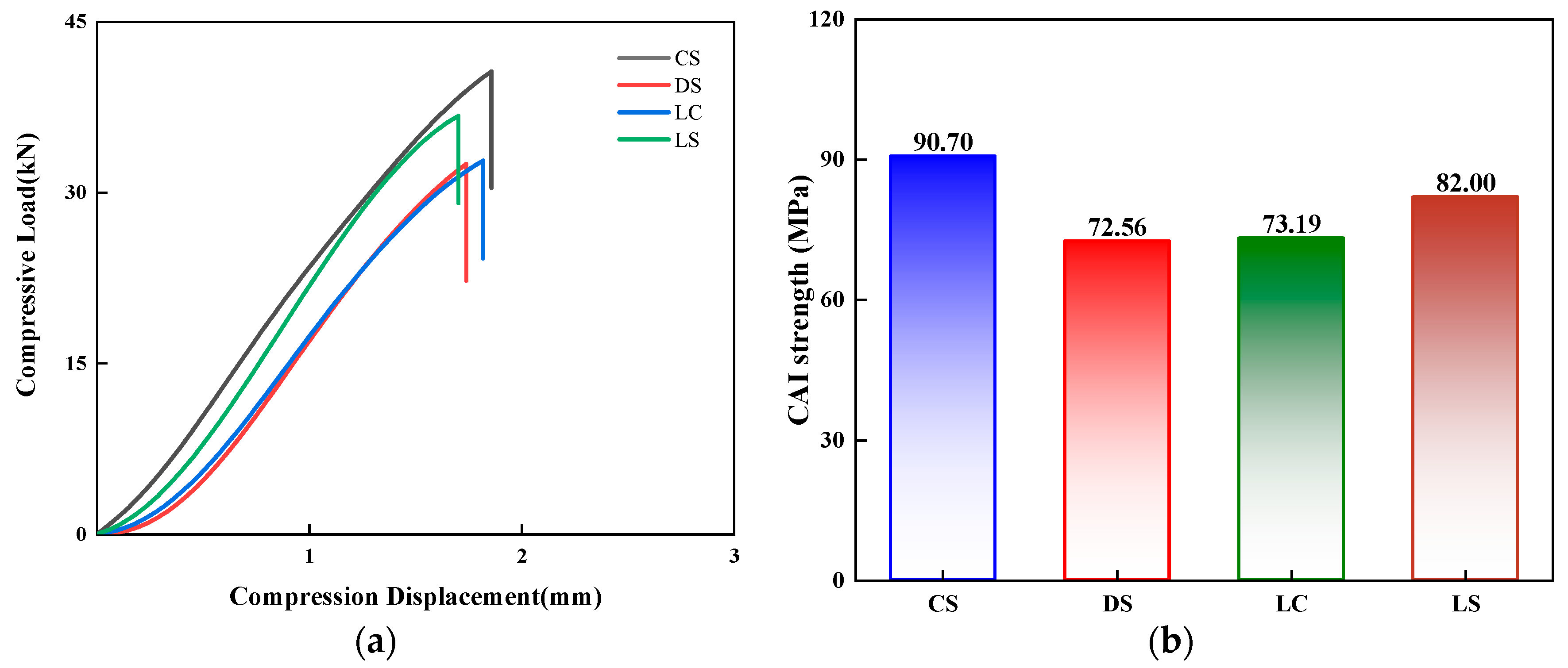
| Laminate Code | Number of Layers | Stacking Sequence | Stacking Angle (°) |
|---|---|---|---|
| CS (Cross-Spiral) | 32 | [G32] | [0/90/6/84/12/78/18/…/78/12/84/6/90/0] |
| SS (Symmetric-Spiral) | [0/6/12/18/…/84/90]s |
| Materials | Glass Fiber Lamina |
|---|---|
| Density (kg/m3) | |
| Modulus (GPa) | |
| Poisson’s ratio | |
| Strength (MPa) | |
| a Intralaminar fracture energy (N/mm) | |
| a Interface modulus (GPa) | |
| a Interface strength (MPa) | |
| a Interface fracture energy (N/mm) |
| Laminate | Peak Force/kN | Maximum Central Displacement/mm | Impact Time/ms | Absorbed Energy/J |
|---|---|---|---|---|
| CS-1st | 0.164 | 0.140 | 0.443 | 0.096 |
| CS-5th | 0.313 | 0.285 | 0.350 | 0.074 |
| CS-10th | 0.116 | 0.150 | 0.189 | 0.089 |
| CS-15th | 0.133 | 0.163 | 0.372 | 0.065 |
| SS-1st | 0.108 | 0.170 | 0.131 | 0.094 |
| SS-5th | 0.104 | 0.160 | 0.142 | 0.068 |
| SS-10th | 0.167 | 0.386 | 0.279 | 0.084 |
| SS-15th | 0.151 | 0.124 | 0.171 | 0.101 |
| p | Peak Force | Maximum Central Displacement | Impact Time | Absorbed Energy | |
|---|---|---|---|---|---|
| Number of Impacts | |||||
| 1 | 0.467 | 0.103 | 0.421 | 0.001 | |
| 5 | 0.359 | 0.570 | 0.006 | 0.110 | |
| 10 | 0.927 | 0.058 | 0.003 | 0.257 | |
| 15 | 0.178 | 0.001 | 0.001 | 0.948 | |
| Laminate Code | Number of Layers | Stacking Sequence | Stacking Angle (°) |
|---|---|---|---|
| DS (Double-Spiral) | 32 | [G32] | [0/6/12/18/…/84/90] + [0/6/12/18/…/84/90] |
| LC (Linear–Cross) | [0/6/12/18/…/84/90] + [0/90/6/84/12/78/18/72/24/ 66/30/60/36/54/42/48] | ||
| LS (Linear–Spiral) | [0/6/12/18/…/84/90/96… 180/186] |
Disclaimer/Publisher’s Note: The statements, opinions and data contained in all publications are solely those of the individual author(s) and contributor(s) and not of MDPI and/or the editor(s). MDPI and/or the editor(s) disclaim responsibility for any injury to people or property resulting from any ideas, methods, instructions or products referred to in the content. |
© 2025 by the authors. Licensee MDPI, Basel, Switzerland. This article is an open access article distributed under the terms and conditions of the Creative Commons Attribution (CC BY) license (https://creativecommons.org/licenses/by/4.0/).
Share and Cite
He, L.; Yao, Z.; Jiang, L.; Guo, Z.; Lyu, Q. Repeated Impact Damage Behavior and Damage Tolerance of Bio-Inspired Helical-Structured Glass Fiber Resin Matrix Composites. Polymers 2025, 17, 1720. https://doi.org/10.3390/polym17131720
He L, Yao Z, Jiang L, Guo Z, Lyu Q. Repeated Impact Damage Behavior and Damage Tolerance of Bio-Inspired Helical-Structured Glass Fiber Resin Matrix Composites. Polymers. 2025; 17(13):1720. https://doi.org/10.3390/polym17131720
Chicago/Turabian StyleHe, Liang, Zhaoyue Yao, Lanlan Jiang, Zaoyang Guo, and Qihui Lyu. 2025. "Repeated Impact Damage Behavior and Damage Tolerance of Bio-Inspired Helical-Structured Glass Fiber Resin Matrix Composites" Polymers 17, no. 13: 1720. https://doi.org/10.3390/polym17131720
APA StyleHe, L., Yao, Z., Jiang, L., Guo, Z., & Lyu, Q. (2025). Repeated Impact Damage Behavior and Damage Tolerance of Bio-Inspired Helical-Structured Glass Fiber Resin Matrix Composites. Polymers, 17(13), 1720. https://doi.org/10.3390/polym17131720





